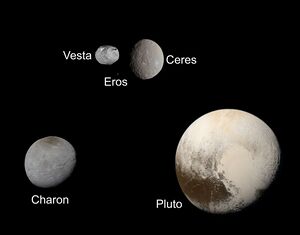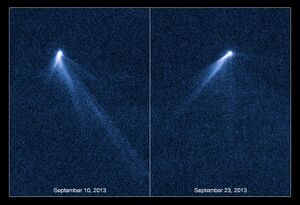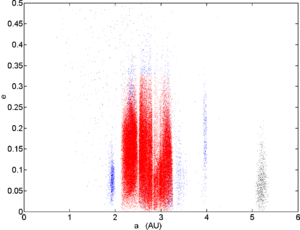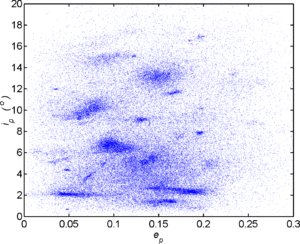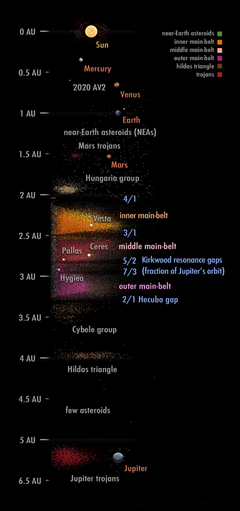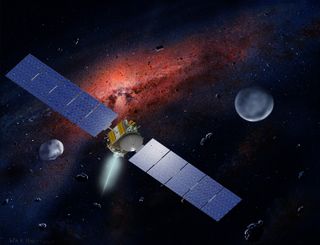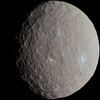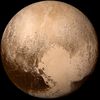حزام الكويكبات
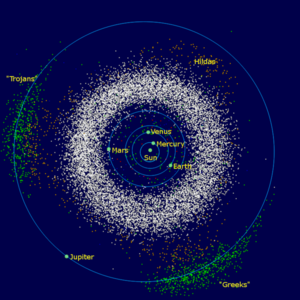
| Sun Jupiter trojans Orbits of planets | Asteroid belt Hilda asteroids (Hildas) Near-Earth objects (selection) |
حزام الكويكبات Asteroid belt (أو الحزام الكوكبي أو نطاق الكويكبات) هي منطقة على شكل طارة في المجموعة الشمسية، المتمركزة حول الشمسس، وتمتد في الفراغ بين مدارى كوكبى المريخ والمشتري. It contains a great many solid, irregularly shaped bodies called asteroids or minor planets. The identified objects are of many sizes, but much smaller than planets, and on average are about one million kilometers (or six hundred thousand miles) apart. This asteroid belt is also called the main asteroid belt or main belt to distinguish it from other asteroid populations in the Solar System.[1]
The asteroid belt is the smallest and innermost known circumstellar disc in the Solar System. Classes of small Solar System bodies in other regions are the near-Earth objects, the centaurs, the Kuiper belt objects, the scattered disc objects, the sednoids, and the Oort cloud objects. About 60% of the main belt mass is contained in the four largest asteroids: Ceres, Vesta, Pallas, and Hygiea. The total mass of the asteroid belt is calculated to be 3% that of the Moon.[2]
Ceres, the only object in the asteroid belt large enough to be a dwarf planet, is about 950 km in diameter, whereas Vesta, Pallas, and Hygiea have mean diameters less than 600 km.[3][4][5][6] The remaining bodies range down to the size of a dust particle. The asteroid material is so thinly distributed that numerous uncrewed spacecraft have traversed it without incident.[7] Nonetheless, collisions between large asteroids occur and can produce an asteroid family, whose members have similar orbital characteristics and compositions. Individual asteroids within the belt are categorized by their spectra, with most falling into three basic groups: carbonaceous (C-type), silicate (S-type), and metal-rich (M-type).
The asteroid belt formed from the primordial solar nebula as a group of planetesimals,[8] the smaller precursors of the protoplanets. Between Mars and Jupiter, however, gravitational perturbations from Jupiter disrupted their accretion into a planet,[8][9] imparting excess kinetic energy which shattered colliding planetesimals and most of the incipient protoplanets. As a result, 99.9% of the asteroid belt's original mass was lost in the first 100 million years of the Solar System's history.[10] Some fragments eventually found their way into the inner Solar System, leading to meteorite impacts with the inner planets. Asteroid orbits continue to be appreciably perturbed whenever their period of revolution about the Sun forms an orbital resonance with Jupiter. At these orbital distances, a Kirkwood gap occurs as they are swept into other orbits.[11]
تاريخ الرصد

لم يعرف التراث الفلكي هذا الحزام الكويكبي وفى العصر الحديث أدرك علماء الفلك أن بين كوكبي المريخ والمشتري فجوة عريضة احتملوا أن يكون فيها كوكب غير مكتشف.
وهذا ما دفع الفلكي كبلر لأن يقول :إنى أضع كوكبا بين المريخ والمشتري ثم جاء الفلكي بود ليضع قانونا سنة 1772م كشف فيه عن علاقة عددية غريبة بين المسافات التى تفصل الكواكب عن الشمس معتقدا أن هناك كوكبا مفقودا في الحزام الواقع بين المريخ والمشتري لكن الاكتشافات اللاحقة كشفت خطأ فكرة بود.
عقب اكتشاف أورانوس عام 1781م، اقترح الفلكي الألماني "يوهان بود" وجود كوكب آخر في الفجوة المدارية بين كوكبي المريخ والمشترى. وفي عام 1801م تم اكتشاف سيريس (الجسم الأكبر في الحزام) في المكان الذي تنبأ به "يوهان بود"، ثم في 1802م اكتشف الفلكي "ولهلم أولبرز" الكويكب "2 بيلاس"، وافترض أن هذا الكويكب والأجسام الصغيرة المحيطة به هي بقايا كوكب مُدَمّر كان يدور في هذا المكان. في عام 1807م تم اكتشاف كويكبين آخرين هما "3 جونو" و"4 فيستا"، ولأن شكل هذين الكويكبين يميل إلى شكل نجمة، فقد أُطلق على هذا النوع من الكويكبات اسم asteroid، والكلمة تصغير لكلمة aster اليونانية التي تعني نجم.
بقيام الحروب التي أشعلها "نابليون بونابرت" في أوروبا، توقفت الاكتشافات الفلكية عند هذا الحد، إلى أن تم استئنافها مرة أخرى عام 1845م باكتشاف الكويكب "5 أسترا". بعد هذا توالت الاكتشافات في منطقة حزام الكويكبات، وبحلول منتصف 1866م كان هناك 100 كويكب قد تم اكتشافه. وبحلول 1923م زاد عدد الكويكبات المكتشفة إلى 1000 كويكب، واليوم نعرف أن عددها يصل إلى بضعة ملايين! حوالي 1.7 مليون منها يصل قطرها إلى كيلومتر أو أكبر قليلا، وهناك حوالي 200 كويكب يتجاوز قطرها 100 كيلومتر.
وفي عام 1800م، أجتمع عدد من علماء الفلك في ألمانيا وقرروا استخدام مراقبهم الجديدة في محاولة للتأكد من وجود كوكب مفترض. وعوضا عن الكوكب المفقود اكتشفت جماعة الفلكيين الألمان، التي اتخذت اسم (الشرطة السماوية) عددا من الكويكبات. ولكن لم يكن النجاح حليفهم إذ حقق هذا الأكتشاف عالم فلكي إيطالي يدعى جيوسبي بيازي. كان هذا العالم يعمل على وضع جدول منظم لمواقع النجوم، حين لاحظ شيئا يبدو كالنجم تماما ولو أنه يتحرك كالكواكب، وغير ثابت نسبيا كالنجوم، وأطلق على هذا الجرم الجديد أسم سيريس (Ceres)، على أسم آلهة الحصاد عند الرومان، وبعد أن راقب الفلكيون هذا الجرم الجديد فترة من الزمن وجدوا أنه يتحرك في مدار بين المريخ والمشتري، وسرعان ما وجدوا أجراما أخرى دعوها بالنجيمات (مصغر نجم) لشبهها بالنجوم، وأطلق عليها فيما بعد الكويكبات.
إن سيريس هو أكبر هذه الكويكبات ويبلغ قطره 670 كيلومتر، أي إن مساحته السطحية تبلغ مساحة العراق تقريبا، وقطر كويكبة بالاس (Pallas)، يبلغ 450 كيلو متر ، تليها كويكبة فستا (Vesta)، التي يبلغ قطرها 385 كيلو متر ، ثم جونو (Juno)، التي يبلغ قطرها240 كيلو مترا، أما الكويكبات الأخرى فالقليل منها يبلغ قطره 240 كيلومتر، وتقع معظمها على بعد يتراوح بين 415 و470 مليون كيلومتر عن الشمس، أي حيث يتوقع وجود الكوكب المجهول، وقد وجد علماء الفلك في العصر الحديث حوالي ألفي كويكبة، بعضها لا يعدو أن يكون مجرد كرة لعب صغيرة، ومن المحتمل أنها كانت في السابق كوكبا جميلا ثم أنفجر وتطاير قطعا قبل ملايين السنين.
ومن هذه الكويكبات ما يدور حول مدار المشتري وقد أكتشف إن عددها يتراوح نحو 12 كويكبا صغيرا، وهي تدعى مجموعة طروادة، وقد أكتشف أكبرها عام 1906م، وسميت كويكبة آخيل.
عام 1918 اكتشف الفلكي الياباني "كيوتسوجو هيراياما" أن بعض الكويكبات تدور معا في مجموعات أطلق عليها فيما بعد عائلات، وفي السبعينيات تم تصنيف الكويكبات إلى ثلاث مجموعات وفقا للتركيب: المجموعة الأولى هي الكويكبات الكربونية وهي تمثل حوالي 75% من الكويكبات وتقع بالقرب من مدار المشترى، المجموعة الثانية هي الكويكبات السيليكية وتمثل 17% من الكويكبات، والثالثة هي الكويكبات المعدنية وتمثل النسبة الباقية.
عام 2006 تم اكتشاف مجموعة من المذنبات تدور في حزام الكويكبات.
الأصل
التشكل
In 1802, shortly after discovering Pallas, Olbers suggested to Herschel that Ceres and Pallas were fragments of a much larger planet that once occupied the Mars–Jupiter region, with this planet having suffered an internal explosion or a cometary impact many million years before,[12] while Odesan astronomer K. N. Savchenko suggested that Ceres, Pallas, Juno, and Vesta were escaped moons rather than fragments of the exploded planet.[13] The large amount of energy required to destroy a planet, combined with the belt's low combined mass, which is only about 4% of the mass of Earth's Moon,[3] does not support these hypotheses. Further, the significant chemical differences between the asteroids become difficult to explain if they come from the same planet.[14]
A modern hypothesis for the asteroid belt's creation relates to how, in general for the Solar System, planetary formation is thought to have occurred via a process comparable to the long-standing nebular hypothesis; a cloud of interstellar dust and gas collapsed under the influence of gravity to form a rotating disc of material that then conglomerated to form the Sun and planets.[15] During the first few million years of the Solar System's history, an accretion process of sticky collisions caused the clumping of small particles, which gradually increased in size. Once the clumps reached sufficient mass, they could draw in other bodies through gravitational attraction and become planetesimals. This gravitational accretion led to the formation of the planets.[16]
Planetesimals within the region that would become the asteroid belt were strongly perturbed by Jupiter's gravity.[17] Orbital resonances occurred where the orbital period of an object in the belt formed an integer fraction of the orbital period of Jupiter, perturbing the object into a different orbit; the region lying between the orbits of Mars and Jupiter contains many such orbital resonances. As Jupiter migrated inward following its formation, these resonances would have swept across the asteroid belt, dynamically exciting the region's population and increasing their velocities relative to each other.[18] In regions where the average velocity of the collisions was too high, the shattering of planetesimals tended to dominate over accretion,[19] preventing the formation of a planet. Instead, they continued to orbit the Sun as before, occasionally colliding.[17]
During the early history of the Solar System, the asteroids melted to some degree, allowing elements within them to be partially or completely differentiated by mass. Some of the progenitor bodies may even have undergone periods of explosive volcanism and formed magma oceans. Because of the relatively small size of the bodies, though, the period of melting was necessarily brief compared to the much larger planets, and had generally ended about 4.5 billion years ago, in the first tens of millions of years of formation.[20] In August 2007, a study of zircon crystals in an Antarctic meteorite believed to have originated from Vesta suggested that it, and by extension the rest of the asteroid belt, had formed rather quickly, within 10 million years of the Solar System's origin.[21]
التطور
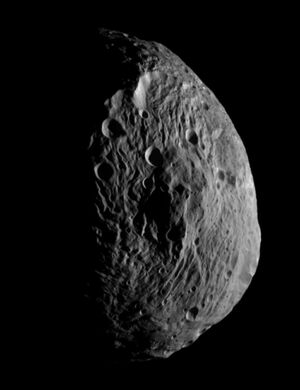
The asteroids are not pristine samples of the primordial Solar System. They have undergone considerable evolution since their formation, including internal heating (in the first few tens of millions of years), surface melting from impacts, space weathering from radiation, and bombardment by micrometeorites.[22][23][24][25] Although some scientists refer to the asteroids as residual planetesimals,[26] other scientists consider them distinct.[27]
The current asteroid belt is believed to contain only a small fraction of the mass of the primordial belt. Computer simulations suggest that the original asteroid belt may have contained mass equivalent to the Earth's.[28] Primarily because of gravitational perturbations, most of the material was ejected from the belt within about 1 million years of formation, leaving behind less than 0.1% of the original mass.[17] Since its formation, the size distribution of the asteroid belt has remained relatively stable; no significant increase or decrease in the typical dimensions of the main-belt asteroids has occurred.[29]
The 4:1 orbital resonance with Jupiter, at a radius 2.06 astronomical units (AUs), can be considered the inner boundary of the asteroid belt. Perturbations by Jupiter send bodies straying there into unstable orbits. Most bodies formed within the radius of this gap were swept up by Mars (which has an aphelion at 1.67 AU) or ejected by its gravitational perturbations in the early history of the Solar System.[30] The Hungaria asteroids lie closer to the Sun than the 4:1 resonance, but are protected from disruption by their high inclination.[31]
When the asteroid belt was first formed, the temperatures at a distance of 2.7 AU from the Sun formed a "snow line" below the freezing point of water. Planetesimals formed beyond this radius were able to accumulate ice.[32][33] In 2006, a population of comets had been discovered within the asteroid belt beyond the snow line, which may have provided a source of water for Earth's oceans. According to some models, outgassing of water during the Earth's formative period was insufficient to form the oceans, requiring an external source such as a cometary bombardment.[34]
The outer asteroid belt appears to include a few objects that may have arrived there during the last few hundred years, the list includes (457175) 2008 GO98 also known as 362P.[35]
السمات
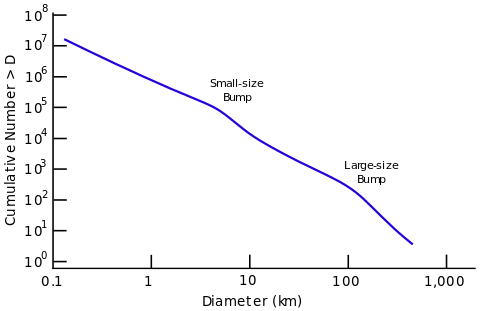
تملأ هذا الشريط كويكبات واحجار وحصى وأتربة يصل أكبرها الى نحو 940 كيلو مترا هو سيرس (كويكب). وأصغرها حصى ورمال وفتات يدور كل واحد من هذة الأجرام في مدار له ضمن هذا الشريط .
الموقع
لم يكن العلماء يعلمون بوجودها حتى عام 1801م، حيث إن الكواكب المختلفة تدور حول الشمس في مدارات أهليجية بيضوية ثابتة، وأقربها كوكب عطارد وأبعدها كوكب بلوتو، وما أن بدا العلماء يعرفون المزيد عن تحركات الكواكب حول الشمس حتى لاحظوا إن كل كوكب يبعد عن الشمس ما يتراوح بين مرة وربع المرة، إلى المرتين بالنسبة إلى بعد الكوكب السابق عن الشمس، ثم لاحظوا إن ذلك غير صحيح بالنسبة للمريخ وللمشتري، إذ يبعد المريخ نحو 228 مليون كيلومتر عن الشمس، ويجب على هذا الأساس أن يكون المشتري على مسافة 402 مليون كيلو متر من الشمس، ولكنه في الحقيقة يقع على ضعفي هذه المسافة مما يوحي بوجود كوكب آخر يدور في هذه الفسحة بين المريخ والمشتري.
يقع الشريط على مسافة تقدر بين وحدتين فلكيتين و3و1\2 وحدة فلكية تقطع هذة الكويكبات المتنوعة دورتها حول الشمس (أى سنتها) في حدود 3-6 سوات.
السمات

Contrary to popular imagery, the asteroid belt is mostly empty. The asteroids are spread over such a large volume that reaching an asteroid without aiming carefully would be improbable. Nonetheless, hundreds of thousands of asteroids are currently known, and the total number ranges in the millions or more, depending on the lower size cutoff. Over 200 asteroids are known to be larger than 100 km,[38] and a survey in the infrared wavelengths has shown that the asteroid belt has between 700,000 and 1.7 million asteroids with a diameter of 1 km or more.[39]
The number of asteroids in the main belt steadily increases with decreasing size. Although the size distribution generally follows a power law, there are 'bumps' in the curve at about 5 km and 100 km, where more asteroids than expected from such a curve are found. Most asteroids larger than approximately 120 km in diameter are primordial, having survived from the accretion epoch, whereas most smaller asteroids are products of fragmentation of primordial asteroids. The primordial population of the main belt was probably 200 times what it is today.[40][41]
The absolute magnitudes of most of the known asteroids are between 11 and 19, with the median at about 16.[42] On average the distance between the asteroids is about 965،600 km (600،000 mi),[43][44] although this varies among asteroid families and smaller undetected asteroids might be even closer. The total mass of the asteroid belt is estimated to be 2.39×1021 kg, which is just 3% of the mass of the Moon.[2] The four largest objects, Ceres, Vesta, Pallas, and Hygiea, contain an estimated 62% of the belt's total mass, with 39% accounted for by Ceres alone.[45][5]
التكوين
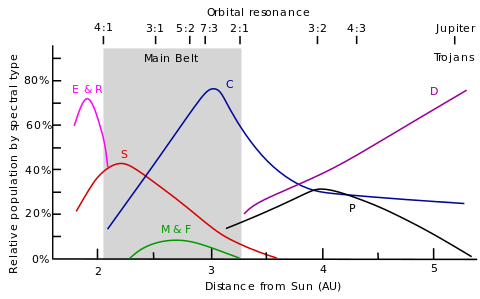
The present day belt consists primarily of three categories of asteroids: C-type carbonaceous asteroids, S-type silicate asteroids, and a hybrid group of X-type asteroids. The latter have featureless spectra, but they can be divided into three groups based on reflectivity, yielding the M-type metallic, P-type primitive, and E-type enstatite asteroids. Additional types have been found that do not fit within these primary classes. There is a compositional trend of asteroid types by increasing distance from the Sun, in the order of S, C, P, and the spectrally-featureless D-types.[47]
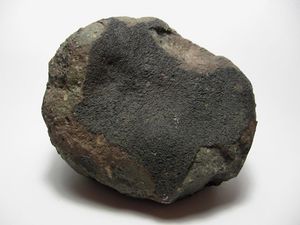
Carbonaceous asteroids, as their name suggests, are carbon-rich. They dominate the asteroid belt's outer regions,[48] and are rare in the inner belt.[47] Together they comprise over 75% of the visible asteroids. They are redder in hue than the other asteroids and have a very low albedo. Their surface compositions are similar to carbonaceous chondrite meteorites. Chemically, their spectra match the primordial composition of the early Solar System, with the lighter elements and volatiles removed.[49]
S-type (silicate-rich) asteroids are more common toward the inner region of the belt, within 2.5 AU of the Sun.[48][50] The spectra of their surfaces reveal the presence of silicates and some metal, but no significant carbonaceous compounds. This indicates that their materials have been significantly modified from their primordial composition, probably through melting and reformation. They have a relatively high albedo and form about 17% of the total asteroid population.[49]
M-type (metal-rich) asteroids are typically found in the middle of the main belt, and they make up much of the remainder of the total population.[49] Their spectra resemble that of iron-nickel. Some are believed to have formed from the metallic cores of differentiated progenitor bodies that were disrupted through collision. However, some silicate compounds also can produce a similar appearance. For example, the large M-type asteroid 22 Kalliope does not appear to be primarily composed of metal.[51] Within the asteroid belt, the number distribution of M-type asteroids peaks at a semimajor axis of about 2.7 AU.[52] Whether all M-types are compositionally similar, or whether it is a label for several varieties which do not fit neatly into the main C and S classes is not yet clear.[53]
One mystery is the relative rarity of V-type (Vestoid) or basaltic asteroids in the asteroid belt.[54] Theories of asteroid formation predict that objects the size of Vesta or larger should form crusts and mantles, which would be composed mainly of basaltic rock, resulting in more than half of all asteroids being composed either of basalt or olivine. However, observations suggest that 99% of the predicted basaltic material is missing.[55] Until 2001, most basaltic bodies discovered in the asteroid belt were believed to originate from the asteroid Vesta (hence their name V-type), but the discovery of the asteroid 1459 Magnya revealed a slightly different chemical composition from the other basaltic asteroids discovered until then, suggesting a different origin.[55] This hypothesis was reinforced by the further discovery in 2007 of two asteroids in the outer belt, 7472 Kumakiri and (10537) 1991 RY16, with a differing basaltic composition that could not have originated from Vesta. These latter two are the only V-type asteroids discovered in the outer belt to date.[54]
The temperature of the asteroid belt varies with the distance from the Sun. For dust particles within the belt, typical temperatures range from 200 K (−73 °C) at 2.2 AU down to 165 K (−108 °C) at 3.2 AU.[57] However, due to rotation, the surface temperature of an asteroid can vary considerably as the sides are alternately exposed to solar radiation and then to the stellar background.
مذنبات الحزام الرئيسي
Several otherwise unremarkable bodies in the outer belt show cometary activity. Because their orbits cannot be explained through the capture of classical comets, many of the outer asteroids are thought to be icy, with the ice occasionally exposed to sublimation through small impacts. Main-belt comets may have been a major source of the Earth's oceans because the deuterium-hydrogen ratio is too low for classical comets to have been the principal source.[58]
المدارات
Most asteroids within the asteroid belt have orbital eccentricities of less than 0.4, and an inclination of less than 30°. The orbital distribution of the asteroids reaches a maximum at an eccentricity around 0.07 and an inclination below 4°.[42] Thus, although a typical asteroid has a relatively circular orbit and lies near the plane of the ecliptic, some asteroid orbits can be highly eccentric or travel well outside the ecliptic plane.
Sometimes, the term "main belt" is used to refer only to the more compact "core" region where the greatest concentration of bodies is found. This lies between the strong 4:1 and 2:1 Kirkwood gaps at 2.06 and 3.27 AU, and at orbital eccentricities less than roughly 0.33, along with orbital inclinations below about 20°. اعتبارا من 2006[تحديث], this "core" region contained 93% of all discovered and numbered minor planets within the Solar System.[59] The JPL Small-Body Database lists over 1 million known main-belt asteroids.[60]
Kirkwood gaps
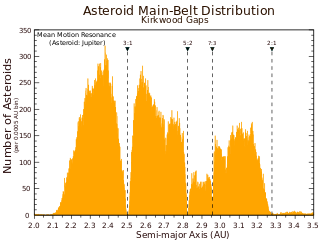
I: inner main-belt (a < 2.5 AU)
II: middle main-belt (2.5 AU < a < 2.82 AU)
III: outer main-belt (a > 2.82 AU)
The semimajor axis of an asteroid is used to describe the dimensions of its orbit around the Sun, and its value determines the minor planet's orbital period. In 1866, Daniel Kirkwood announced the discovery of gaps in the distances of these bodies' orbits from the Sun. They were located in positions where their period of revolution about the Sun was an integer fraction of Jupiter's orbital period. Kirkwood proposed that the gravitational perturbations of the planet led to the removal of asteroids from these orbits.[61]
When the mean orbital period of an asteroid is an integer fraction of the orbital period of Jupiter, a mean-motion resonance with the gas giant is created that is sufficient to perturb an asteroid to new orbital elements. Primordial asteroids entered these gaps because of the migration of Jupiter's orbit.[62] Subsequently, asteroids primarily migrate into these gap orbits due to the Yarkovsky effect,[47] but may also enter because of perturbations or collisions. After entering, an asteroid is gradually nudged into a different, random orbit with a larger or smaller semimajor axis.
التفسير
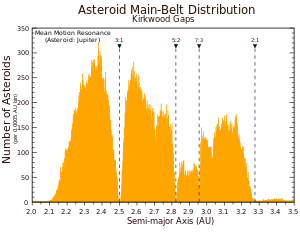
فسر علماء الفلك مكونات هذا الشريط بأكثر من تفسير أهمها أنها انقاض أو بقايا من السديم الذى كون النظام الشمسي لم تتح له الفرصة ليكون كوكبا سيارا . وقال آخرون إنها بقايا كوكب محطم وتقدر الكتلة الإجمالية لمحتوى هذا الحزام بنحو 1\2,000 من كوكب الأرض فلو كان كوكبا سيارا لكان صغيرا.
من المرجح أن هذه الكويكبات قد نتجت عن السديم الأساسي الذي تكونت منه المجموعة الشمسية، وتمثل هذه الكويكبات الصغيرة أنوية لكواكب، إلا أن الجاذبية الهائلة لكوكب المشترى تمنعها من التجمع لتكوين كواكب أكبر، كما أن جاذبيته تؤدي إلى المزيد من التصادم بينها، وتمتص معظم الركام الصغير الناجم عن التصادم. وعلى فترات دورية، تضطرب مدارات الكويكبات كلما حدث ما يسمى بالرنين المداري مع المشترى، مما يؤدي إلى تغييرات دورية في مسارات الكويكبات.
تتركز كتلة حزام الكويكبات في الأجسام الكبيرة التي تدور فيها، وأكبر الكويكبات الموجودة هي ثلاثة أجسام يزيد متوسط قطرها عن 400 كيلومتر. الكويكبات الكبيرة الثلاثة هي "4 فيستا" و"2 بيلاس" و"10 هيجيا". وفي الحزام أيضا يدور الكوكب القزم سيريس الذي تحدثنا عنه بالتفصيل من قبل، ويبلغ قطر سيريس حوالي 950 كيلومتر، وهكذا فإن سيريس والأجرام الثلاثة الكبيرة الأخرى يشكلون حوالي نصف كتلة حزام الكويكبات. باقي الأجسام التي تدور في الحزام تتفاوت في الصغر بين كويكبات صغيرة تقل عن الثلاثة الكبار وحجم حبة التراب.
توزيع الكويكبات ليس كثيفا، لهذا فمن الممكن أن تمر المركبات الفضائية عبرها دون مشاكل، على عكس أفلام الفضاء التي تظهر حزام الكويكبات كحقل ألغام للمركبات الفضائية، ويظل البطل يقوم بحركات بهلوانية بمركبته الفضائية ويدور في كل الاتجاهات ليتفادى الاصطدام! وحتى اليوم لم تتعرض أية مركبة فضائية مرت بالحزام لأي حادث.
التصادم

The high population of the asteroid belt makes for a very active environment, where collisions between asteroids occur frequently (on astronomical time scales). Impact events between main-belt bodies with a mean radius of 10 km are expected to occur about once every 10 million years.[63] A collision may fragment an asteroid into numerous smaller pieces (leading to the formation of a new asteroid family).[64] Conversely, collisions that occur at low relative speeds may also join two asteroids. After more than 4 billion years of such processes, the members of the asteroid belt now bear little resemblance to the original population.
Evidence suggests that most main belt asteroids between 200 m and 10 km in diameter are rubble piles formed by collisions. These bodies consist of a multitude of irregular objects that are mostly bound together by self-gravity, resulting in significant amounts of internal porosity.[65] Along with the asteroid bodies, the asteroid belt also contains bands of dust with particle radii of up to a few hundred micrometres. This fine material is produced, at least in part, from collisions between asteroids, and by the impact of micrometeorites upon the asteroids. Due to the Poynting–Robertson effect, the pressure of solar radiation causes this dust to slowly spiral inward toward the Sun.[66]
The combination of this fine asteroid dust, as well as ejected cometary material, produces the zodiacal light. This faint auroral glow can be viewed at night extending from the direction of the Sun along the plane of the ecliptic. Asteroid particles that produce visible zodiacal light average about 40 μm in radius. The typical lifetimes of main-belt zodiacal cloud particles are about 700,000 years. Thus, to maintain the bands of dust, new particles must be steadily produced within the asteroid belt.[66] It was once thought that collisions of asteroids form a major component of the zodiacal light. However, computer simulations by Nesvorný and colleagues attributed 85 percent of the zodiacal-light dust to fragmentations of Jupiter-family comets, rather than to comets and collisions between asteroids in the asteroid belt. At most 10 percent of the dust is attributed to the asteroid belt.[67]
النيازك
Some of the debris from collisions can form meteoroids that enter the Earth's atmosphere.[68] Of the 50,000 meteorites found on Earth to date, 99.8 percent are believed to have originated in the asteroid belt.[69]
الأسر والجماعات
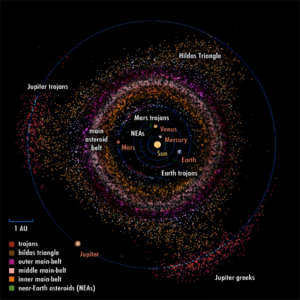
In 1918, the Japanese astronomer Kiyotsugu Hirayama noticed that the orbits of some of the asteroids had similar parameters, forming families or groups.[70]
Approximately one-third of the asteroids in the asteroid belt are members of an asteroid family. These share similar orbital elements, such as semi-major axis, eccentricity, and orbital inclination as well as similar spectral features, all of which indicate a common origin in the breakup of a larger body. Graphical displays of these element pairs, for members of the asteroid belt, show concentrations indicating the presence of an asteroid family. There are about 20 to 30 associations that are almost certainly asteroid families. Additional groupings have been found that are less certain. Asteroid families can be confirmed when the members display similar spectral features.[71] Smaller associations of asteroids are called groups or clusters.
Some of the most prominent families in the asteroid belt (in order of increasing semi-major axes) are the Flora, Eunomia, Koronis, Eos, and Themis families.[52] The Flora family, one of the largest with more than 800 known members, may have formed from a collision less than 1 billion years ago.[72] The largest asteroid to be a true member of a family is 4 Vesta. (This is in contrast to an interloper, in the case of Ceres with the Gefion family.) The Vesta family is believed to have formed as the result of a crater-forming impact on Vesta. Likewise, the HED meteorites may also have originated from Vesta as a result of this collision.[73]
Three prominent bands of dust have been found within the asteroid belt. These have similar orbital inclinations as the Eos, Koronis, and Themis asteroid families, and so are possibly associated with those groupings.[74]
The main belt evolution after the Late Heavy Bombardment was very likely affected by the passages of large Centaurs and trans-Neptunian objects (TNOs). Centaurs and TNOs that reach the inner Solar System can modify the orbits of main belt asteroids, though only if their mass is of the order of 10−9 M☉ for single encounters or, one order less in case of multiple close encounters. However, Centaurs and TNOs are unlikely to have significantly dispersed young asteroid families in the main belt, although they can have perturbed some old asteroid families. Current main belt asteroids that originated as Centaurs or trans-Neptunian objects may lie in the outer belt with short lifetime of less than 4 million years, most likely orbiting between 2.8 and 3.2 AU at larger eccentricities than typical of main belt asteroids.[75]
Periphery
Skirting the inner edge of the belt (ranging between 1.78 and 2.0 AU, with a mean semi-major axis of 1.9 AU) is the Hungaria family of minor planets. They are named after the main member, 434 Hungaria; the group contains at least 52 named asteroids. The Hungaria group is separated from the main body by the 4:1 Kirkwood gap and their orbits have a high inclination. Some members belong to the Mars-crossing category of asteroids, and gravitational perturbations by Mars are likely a factor in reducing the total population of this group.[31]
Another high-inclination group in the inner part of the asteroid belt is the Phocaea family. These are composed primarily of S-type asteroids, whereas the neighboring Hungaria family includes some E-types.[76] The Phocaea family orbit between 2.25 and 2.5 AU from the Sun.[77]
Skirting the outer edge of the asteroid belt is the Cybele group, orbiting between 3.3 and 3.5 AU. These have a 7:4 orbital resonance with Jupiter. The Hilda family orbit between 3.5 and 4.2 AU with relatively circular orbits and a stable 3:2 orbital resonance with Jupiter. There are few asteroids beyond 4.2 AU, until Jupiter's orbit. At the latter the two families of Trojan asteroids can be found, which, at least for objects larger than 1 km, are approximately as numerous as the asteroids of the asteroid belt.[78]
New families
Some asteroid families have formed recently, in astronomical terms. The Karin family apparently formed about 5.7 million years ago from a collision with a progenitor asteroid 33 km in radius.[79] The Veritas family formed about 8.3 million years ago; evidence includes interplanetary dust recovered from ocean sediment.[80]
More recently, the Datura cluster appears to have formed about 530,000 years ago from a collision with a main-belt asteroid. The age estimate is based on the probability of the members having their current orbits, rather than from any physical evidence. However, this cluster may have been a source for some zodiacal dust material.[81][82] Other recent cluster formations, such as the Iannini cluster (ح. 1–5 million years ago), may have provided additional sources of this asteroid dust.[83]
استكشاف
يؤدي العدد الكبير من الكويكبات في منطقة الحزام إلى الكثير من التصادمات فيما بينها، مما يجعلها بيئة نشطة، ويبلغ معدل التصادمات بين الأجرام التي يزيد قطرها على 10 كيلومترات: مرة كل عشرة ملايين عام، وهو معدل كبير بالمقياس الفلكي! ويؤدي التصادم عادة إلى تفتت الكويكب إلى أجزاء صغيرة عديدة، بعضها يصبح مجموعة كويكبات أخرى ويستمر في الدوران في المنطقة، وبعض الأجزاء الأخرى تتحول إلى نيازك تهبط إلى الكواكب الأخرى ومنها الأرض، أو شهب تحترق في المجال الجوي. وينتج عن التصادمات أيضا كميات كبيرة من التراب تستمر في الدوران في المنطقة. في أحيان أخرى -عندما تكون سرعة الدوران بطيئة- يؤدي التصادم إلى التصاق كويكبين معا. وعلى مدى أربعة مليارات سنة هي عمر الحزام، تغيّر شكل الكويكبات التي تدور فيه تماما عما كان وقت تكونه بسبب هذه التصادمات. Cassini measured plasma and fine dust grains while traversing the belt in 2000.[84] On its way to Jupiter, Juno traversed the asteroid belt without collecting science data.[85] Due to the low density of materials within the belt, the odds of a probe running into an asteroid are estimated at less than 1 in 1 billion.[86]
Most main belt asteroids imaged to date have come from brief flyby opportunities by probes headed for other targets. Only the Dawn mission has studied main belt asteroids for a protracted period in orbit. The Galileo spacecraft imaged 951 Gaspra in 1991 and 243 Ida in 1993, then NEAR imaged 253 Mathilde in 1997 and landed on near–Earth asteroid 433 Eros in February 2001. Cassini imaged 2685 Masursky in 2000, Stardust imaged 5535 Annefrank in 2002, New Horizons imaged 132524 APL in 2006, and Rosetta imaged 2867 Šteins in September 2008 and 21 Lutetia in July 2010. Dawn orbited Vesta between July 2011 and September 2012 and has orbited Ceres since March 2015.[87]
The Lucy space probe is expected to make a flyby of 152830 Dinkinesh in 2023, on its way to the Jupiter Trojans.[88] ESA's JUICE mission will pass through the asteroid belt twice, with a proposed flyby of the asteroid 223 Rosa in 2029.[89] The Psyche spacecraft is a planned NASA mission to the large M-type asteroid 16 Psyche.[90]
انظر أيضا
المصادر
- ^ Williams, Matt (2015-08-23). "What is the Asteroid Belt?". Universe Today. Retrieved 2016-01-30.
- ^ أ ب Pitjeva, E. V. (2018). "Masses of the Main Asteroid Belt and the Kuiper Belt from the Motions of Planets and Spacecraft". Solar System Research. 44 (8–9): 554–566. arXiv:1811.05191. Bibcode:2018AstL...44..554P. doi:10.1134/S1063773718090050. S2CID 119404378.
- ^ أ ب Krasinsky, G. A.; Pitjeva, E. V.; Vasilyev, M. V.; Yagudina, E. I. (July 2002). "Hidden Mass in the Asteroid Belt". Icarus. 158 (1): 98–105. Bibcode:2002Icar..158...98K. doi:10.1006/icar.2002.6837.
- ^ Pitjeva, E. V. (2005). "High-Precision Ephemerides of Planets—EPM and Determination of Some Astronomical Constants" (PDF). Solar System Research. 39 (3): 176–186. Bibcode:2005SoSyR..39..176P. doi:10.1007/s11208-005-0033-2. S2CID 120467483. Archived from the original (PDF) on July 3, 2014.
- ^ أ ب For recent estimates of the masses of Ceres, Vesta, Pallas and Hygiea, see the references in the infoboxes of their respective articles.
- ^ Yeomans, Donald K. (July 13, 2006). "JPL Small-Body Database Browser". NASA JPL. Archived from the original on 29 September 2010. Retrieved 2010-09-27.
- ^ Koberlein, Brian (2014-03-12). "Why the Asteroid Belt Doesn't Threaten Spacecraft". Universe Today. Retrieved 2016-01-30.
- ^ أ ب "How Did The Asteroid Belt Form? Was There A Planet There?". CosmosUp. 2016-01-17. Retrieved 2016-01-30.
- ^ Redd, Nola Taylor (2012-06-11). "Asteroid Belt: Facts & Information". Space.com. Retrieved 2016-01-30.
- ^ Beatty, Kelly (March 10, 2009). "Sculpting the Asteroid Belt". Sky & Telescope. Retrieved 2014-04-30.
- ^ Delgrande, J. J.; Soanes, S. V. (1943). "Kirkwood's Gap in the Asteroid Orbits". Journal of the Royal Astronomical Society of Canada. 37: 187. Bibcode:1943JRASC..37..187D.
- ^ "A Brief History of Asteroid Spotting". Open2.net. Archived from the original on 2011-06-11. Retrieved 2007-05-15.
- ^ Bronshten, V. A. (1972). "Origin of the Asteroids". NASA.
- ^ Masetti, M.; Mukai, K. (December 1, 2005). "Origin of the Asteroid Belt". NASA Goddard Spaceflight Center. Retrieved 2007-04-25.
- ^ Watanabe, Susan (July 20, 2001). "Mysteries of the Solar Nebula". NASA. Archived from the original on 2012-01-17. Retrieved 2007-04-02.
- ^ Chambers, John E. (July 2004). "Planetary accretion in the inner Solar System". Earth and Planetary Science Letters. 233 (3–4): 241–252. Bibcode:2004E&PSL.223..241C. doi:10.1016/j.epsl.2004.04.031.
- ^ أ ب ت Petit, J.-M.; Morbidelli, A.; Chambers, J. (2001). "The Primordial Excitation and Clearing of the Asteroid Belt" (PDF). Icarus. 153 (2): 338–347. Bibcode:2001Icar..153..338P. doi:10.1006/icar.2001.6702. Archived (PDF) from the original on 21 February 2007. Retrieved 2007-03-22.
- ^ Scott, E. R. D. (March 13–17, 2006). "Constraints on Jupiter's Age and Formation Mechanism and the Nebula Lifetime from Chondrites and Asteroids"., League City, Texas: Lunar and Planetary Society.
- ^ Edgar, R.; Artymowicz, P. (2004). "Pumping of a Planetesimal Disc by a Rapidly Migrating Planet". Monthly Notices of the Royal Astronomical Society. 354 (3): 769–772. arXiv:astro-ph/0409017. Bibcode:2004MNRAS.354..769E. doi:10.1111/j.1365-2966.2004.08238.x. S2CID 18355985.
- ^ Taylor, G. J.; Keil, K.; McCoy, T.; Haack, H.; Scott, E. R. D. (1993). "Asteroid differentiation – Pyroclastic volcanism to magma oceans". Meteoritics. 28 (1): 34–52. Bibcode:1993Metic..28...34T. doi:10.1111/j.1945-5100.1993.tb00247.x.
- ^ Kelly, Karen (2007). "U of T researchers discover clues to early solar system". University of Toronto. Archived from the original on 2012-02-29. Retrieved 2010-07-12.
- ^ Clark, B. E.; Hapke, B.; Pieters, C.; Britt, D. (2002). "Asteroid Space Weathering and Regolith Evolution". Asteroids III. University of Arizona. p. 585. Bibcode:2002aste.book..585C. doi:10.2307/j.ctv1v7zdn4.44.
{{cite book}}: CS1 maint: location missing publisher (link) - ^ Gaffey, Michael J. (1996). "The Spectral and Physical Properties of Metal in Meteorite Assemblages: Implications for Asteroid Surface Materials". Icarus. 66 (3): 468–486. Bibcode:1986Icar...66..468G. doi:10.1016/0019-1035(86)90086-2. ISSN 0019-1035.
- ^ Keil, K. (2000). "Thermal alteration of asteroids: evidence from meteorites". Planetary and Space Science. Retrieved 2007-11-08.
- ^ Baragiola, R. A.; Duke, C. A.; Loeffler, M.; McFadden, L. A.; Sheffield, J. (2003). "Impact of ions and micrometeorites on mineral surfaces: Reflectance changes and production of atmospheric species in airless solar system bodies". EGS – AGU – EUG Joint Assembly: 7709. Bibcode:2003EAEJA.....7709B.
- ^ Chapman, C. R.; Williams, J. G.; Hartmann, W. K. (1978). "The asteroids". Annual Review of Astronomy and Astrophysics. 16: 33–75. Bibcode:1978ARA&A..16...33C. doi:10.1146/annurev.aa.16.090178.000341.
- ^ Kracher, A. (2005). "Asteroid 433 Eros and partially differentiated planetesimals: bulk depletion versus surface depletion of sulfur" (PDF). Ames Laboratory. Archived (PDF) from the original on 28 November 2007. Retrieved 2007-11-08.
- ^ Piccioni, Robert (2012-11-19). "Did Asteroid Impacts Make Earth Habitable?". Guidetothecosmos.com. Retrieved 2013-05-03.
- ^ Stiles, Lori (September 15, 2005). "Asteroids Caused the Early Inner Solar System Cataclysm". UANews (in الإنجليزية). Retrieved 2018-10-18.
- ^ Alfvén, H.; Arrhenius, G. (1976). "The Small Bodies". SP-345 Evolution of the Solar System. NASA. Archived from the original on 13 May 2007. Retrieved 2007-04-12.
- ^ أ ب Spratt, Christopher E. (April 1990). "The Hungaria group of minor planets". Journal of the Royal Astronomical Society of Canada. 84: 123–131. Bibcode:1990JRASC..84..123S.
- ^ Lecar, M.; Podolak, M.; Sasselov, D.; Chiang, E. (2006). "Infrared cirrus – New components of the extended infrared emission". The Astrophysical Journal. 640 (2): 1115–1118. arXiv:astro-ph/0602217. Bibcode:2006ApJ...640.1115L. doi:10.1086/500287. S2CID 18778001.
- ^ Berardelli, Phil (March 23, 2006). "Main-Belt Comets May Have Been Source Of Earths Water". Space Daily. Retrieved 2007-10-27.
- ^ Lakdawalla, Emily (April 28, 2006). "Discovery of a Whole New Type of Comet". The Planetary Society. Archived from the original on 1 May 2007. Retrieved 2007-04-20.
- ^ de la Fuente Marcos, Carlos; de la Fuente Marcos, Raúl (1 October 2022). "Recent arrivals to the main asteroid belt". Celestial Mechanics and Dynamical Astronomy. 134 (5): 38. arXiv:2207.07013. Bibcode:2022CeMDA.134...38D. doi:10.1007/s10569-022-10094-4.
- ^ Davis, D. R.; Durda, D. D.; Marzari, F.; Campo Bagatin, A.; Gil-Hutton, R. (March 2002). "Collisional Evolution of Small-Body Populations" (PDF). In Bottke Jr., W. F.; Cellino, A.; Paolicchi, P.; Binzel, R. P. (eds.). Asteroids III. Tucson: University of Arizona Press. pp. 545–558. Bibcode:2002aste.book..545D. doi:10.2307/j.ctv1v7zdn4.41. Retrieved 2023-02-11.
- ^ Davis, D. R.; Durda, D. D.; Marzari, F.; Campo Bagatin, A.; Gil-Hutton, R. (March 2002). "Collisional Evolution of Small-Body Populations" (PDF). In Bottke Jr., W. F.; Cellino, A.; Paolicchi, P.; Binzel, R. P. (eds.). Asteroids III. Tucson: University of Arizona Press. pp. 545–558. Bibcode:2002aste.book..545D. doi:10.2307/j.ctv1v7zdn4.41. Retrieved 2023-02-11.
- ^ Yeomans, Donald K. (April 26, 2007). "JPL Small-Body Database Search Engine". NASA JPL. Retrieved 2007-04-26. – search for asteroids in the main belt regions with a diameter >100.
- ^ Tedesco, E. F.; Desert, F.-X. (2002). "The Infrared Space Observatory Deep Asteroid Search". The Astronomical Journal. 123 (4): 2070–2082. Bibcode:2002AJ....123.2070T. doi:10.1086/339482.
- ^ Bottkejr, W.; Durda, D.; Nesvorny, D.; Jedicke, R.; Morbidelli, A.; Vokrouhlicky, D.; Levison, H. (May 2005). "The fossilized size distribution of the main asteroid belt". Icarus (in الإنجليزية). 175 (1): 111–140. Bibcode:2005Icar..175..111B. doi:10.1016/j.icarus.2004.10.026.
- ^ O'Brien, David P.; Sykes, Mark V. (December 2011). "The Origin and Evolution of the Asteroid Belt—Implications for Vesta and Ceres". Space Science Reviews (in الإنجليزية). 163 (1–4): 41–61. Bibcode:2011SSRv..163...41O. doi:10.1007/s11214-011-9808-6. ISSN 0038-6308. S2CID 121856071.
- ^ أ ب Williams, Gareth (September 25, 2010). "Distribution of the Minor Planets". Minor Planets Center. Retrieved 2010-10-27.
- ^ "The asteroid belt contains solar system remnants". EarthSky | Updates on your cosmos and world. 2021-11-03. Retrieved 2023-01-20.
- ^ Williams, Matt (2016-08-10). "How Far is the Asteroid Belt from Earth?". Universe Today. Retrieved 2023-01-20.
- ^ "In Depth | Ceres". NASA Solar System Exploration. Retrieved 2023-02-11.
- ^ Gradie, J.; Tedesco, E. (June 1982). "Compositional Structure of the Asteroid Belt". Science. 216 (4553): 1405–1407. Bibcode:1982Sci...216.1405G. doi:10.1126/science.216.4553.1405. PMID 17798362. S2CID 32447726.
- ^ أ ب ت DeMeo, F. E.; Alexander, C. M. O'D.; Walsh, K. J.; Chapman, C. R.; Binzel, R. P. (2015). Michel, Patrick; DeMeo, Francesca E.; Bottke, William F. (eds.). The Compositional Structure of the Asteroid Belt. Tucson: University of Arizona Press. pp. 13–41. arXiv:1506.04805. Bibcode:2015aste.book...13D. doi:10.2458/azu_uapress_9780816532131-ch002. ISBN 978-0-816-53213-1. S2CID 4648806.
{{cite book}}:|journal=ignored (help) - ^ أ ب Wiegert, P.; Balam, D.; Moss, A.; Veillet, C.; Connors, M.; Shelton, I. (2007). "Evidence for a Color Dependence in the Size Distribution of Main-Belt Asteroids" (PDF). The Astronomical Journal. 133 (4): 1609–1614. arXiv:astro-ph/0611310. Bibcode:2007AJ....133.1609W. doi:10.1086/512128. S2CID 54937918. Archived (PDF) from the original on 2011-07-06. Retrieved 2008-09-06.
- ^ أ ب ت Blair, Edward C., ed. (2002). Asteroids: Overview, Abstracts, and Bibliography. Nova Science Publishers. p. 2. ISBN 978-1-59033-482-9.
- ^ Clark, B. E. (1996). "New News and the Competing Views of Asteroid Belt Geology". Lunar and Planetary Science. 27: 225–226. Bibcode:1996LPI....27..225C.
- ^ Margot, J. L.; Brown, M. E. (2003). "A Low-Density M-type Asteroid in the Main Belt" (PDF). Science. 300 (5627): 1939–1942. Bibcode:2003Sci...300.1939M. doi:10.1126/science.1085844. PMID 12817147. S2CID 5479442. Archived from the original (PDF) on 2020-02-26.
- ^ أ ب Lang, Kenneth R. (2003). "Asteroids and meteorites". NASA's Cosmos. Archived from the original on 2012-03-24. Retrieved 2007-04-02.
- ^ Mueller, M.; Harris, A. W.; Delbo, M. (2005). the MIRSI Team. "21 Lutetia and other M-types: Their sizes, albedos, and thermal properties from new IRTF measurements". Bulletin of the American Astronomical Society. 37: 627. Bibcode:2005DPS....37.0702M.
- ^ أ ب (July 14–18, 2008) "Two New Basaltic Asteroids in the Main Belt?"..
- ^ أ ب Than, Ker (2007). "Strange Asteroids Baffle Scientists". space.com. Retrieved 2007-10-14.
- ^ "When is a comet not a comet?". ESA/Hubble Press Release. Retrieved 12 November 2013.
- ^ Low, F. J.; Beintema, D. A.; Gautier, T. N.; Gillett, F. C.; Beichman, C. A.; Neugebauer, G.; Young, E.; Aumann, H. H.; Boggess, N.; Emerson, J. P.; Habing, H. J.; Hauser, M. G.; Houck, J. R.; Rowan-Robinson, M.; Soifer, B. T.; Walker, R. G.; Wesselius, P. R. (1984). "Infrared cirrus – New components of the extended infrared emission". Astrophysical Journal Letters. 278: L19–L22. Bibcode:1984ApJ...278L..19L. doi:10.1086/184213.
- ^ "Interview with David Jewitt". YouTube.com. 2007-01-05. Archived from the original on 2021-10-30. Retrieved 2011-05-21.
- ^ This value was obtained by a simple count of all bodies in that region using data for 120,437 numbered minor planets from the Minor Planet Center orbit database, dated February 8, 2006.
- ^ "JPL Small-Body Database Search Engine: orbital class (MBA)". JPL Solar System Dynamics. Retrieved 2018-02-26.
- ^ Fernie, J. Donald (1999). "The American Kepler". American Scientist. 87 (5): 398. doi:10.1511/1999.5.398. Retrieved 2007-02-04.
- ^ Liou, Jer-Chyi; Malhotra, Renu (1997). "Depletion of the Outer Asteroid Belt". Science. 275 (5298): 375–377. Bibcode:1997Sci...275..375L. doi:10.1126/science.275.5298.375. hdl:2060/19970022113. PMID 8994031. S2CID 33032137.
- ^ Backman, D. E. (March 6, 1998). "Fluctuations in the General Zodiacal Cloud Density". Backman Report. NASA Ames Research Center. Archived from the original on March 3, 2012. Retrieved 2007-04-04.
- ^ Nesvorný, David; Bottke Jr, William F.; Dones, Luke; Levison, Harold F. (June 2002). "The recent breakup of an asteroid in the main-belt region" (PDF). Nature. 417 (6890): 720–722. Bibcode:2002Natur.417..720N. doi:10.1038/nature00789. PMID 12066178. S2CID 4367081. Archived (PDF) from the original on 2004-08-07.
- ^ Walsh, Kevin J. (September 2018). "Rubble Pile Asteroids". Annual Review of Astronomy and Astrophysics. 56: 593–624. arXiv:1810.01815. Bibcode:2018ARA&A..56..593W. doi:10.1146/annurev-astro-081817-052013. S2CID 119530506.
- ^ أ ب Reach, William T. (1992). "Zodiacal emission. III – Dust near the asteroid belt". Astrophysical Journal. 392 (1): 289–299. Bibcode:1992ApJ...392..289R. doi:10.1086/171428.
- ^ Nesvorný, David; Jenniskens, Peter; Levison, Harold F.; Bottke, William F.; Vokrouhlický, David; Gounelle, Matthieu (2010). "Cometary Origin of the Zodiacal Cloud and Carbonaceous Micrometeorites. Implications for Hot Debris Disks". The Astrophysical Journal. 713 (2): 816–836. arXiv:0909.4322. Bibcode:2010ApJ...713..816N. doi:10.1088/0004-637X/713/2/816. S2CID 18865066.
- ^ Kingsley, Danny (May 1, 2003). "Mysterious meteorite dust mismatch solved". ABC Science. Retrieved 2007-04-04.
- ^ "Meteors and Meteorites" (PDF). NASA. Archived from the original (PDF) on 2006-10-15. Retrieved 2012-01-12.
- ^ Hughes, David W. (2007). "Finding Asteroids In Space". BBC. Archived from the original on 2012-03-10. Retrieved 2007-04-20.
- ^ Lemaitre, Anne (August 31 – September 4, 2004). "Asteroid family classification from very large catalogues".: 135–144, Belgrade, Serbia and Montenegro: Cambridge University Press. doi:10.1017/S1743921304008592.
- ^ Martel, Linda M. V. (March 9, 2004). "Tiny Traces of a Big Asteroid Breakup". Planetary Science Research Discoveries. Archived from the original on 1 April 2007. Retrieved 2007-04-02.
- ^ Drake, Michael J. (2001). "The eucrite/Vesta story". Meteoritics & Planetary Science. 36 (4): 501–513. Bibcode:2001M&PS...36..501D. doi:10.1111/j.1945-5100.2001.tb01892.x.
- ^ Love, S. G.; Brownlee, D. E. (1992). "The IRAS dust band contribution to the interplanetary dust complex – Evidence seen at 60 and 100 microns". Astronomical Journal. 104 (6): 2236–2242. Bibcode:1992AJ....104.2236L. doi:10.1086/116399.
- ^ Galiazzo, M. A.; Wiegert, P.; Aljbaae, S. (2016). "Influence of the Centaurs and TNOs on the main belt and its families". Astrophysics and Space Science. 361 (12): 361–371. arXiv:1611.05731. Bibcode:2016Ap&SS.361..371G. doi:10.1007/s10509-016-2957-z. S2CID 118898917.
- ^ Carvano, J. M.; Lazzaro, D.; Mothé-Diniz, T.; Angeli, C. A.; Florczak, M. (2001). "Spectroscopic Survey of the Hungaria and Phocaea Dynamical Groups". Icarus. 149 (1): 173–189. Bibcode:2001Icar..149..173C. doi:10.1006/icar.2000.6512.
- ^ Bojan Novaković, Georgios Tsirvoulis, Mikael Granvik, and Ana Todović (2017-05-25). "A Dark Asteroid Family in the Phocaea Region". The Astronomical Journal. 153 (6): 266. arXiv:1704.06088. Bibcode:2017AJ....153..266N. doi:10.3847/1538-3881/aa6ea8. S2CID 96428710.
{{cite journal}}: CS1 maint: multiple names: authors list (link) CS1 maint: unflagged free DOI (link) - ^ Dymock, Roger (2010). Asteroids and Dwarf Planets and How to Observe Them. Astronomers' Observing Guides. Springer. p. 24. ISBN 978-1-4419-6438-0. Retrieved 2011-04-04.
- ^ Nesvorný, David; Enke, Brian L.; Bottke, William F.; Durda, Daniel D.; Asphaug, Erik; Richardson, Derek C. (August 2006). "Karin cluster formation by asteroid impact". Icarus. 183 (2): 296–311. Bibcode:2006Icar..183..296N. doi:10.1016/j.icarus.2006.03.008.
- ^ McKee, Maggie (January 18, 2006). "Eon of dust storms traced to asteroid smash". New Scientist Space. Retrieved 2007-04-15.
- ^ Nesvorný, D.; Vokrouhlický, D.; Bottke, W. F. (2006). "The Breakup of a Main-Belt Asteroid 450 Thousand Years Ago" (PDF). Science. 312 (5779): 1490. Bibcode:2006Sci...312.1490N. doi:10.1126/science.1126175. PMID 16763141. S2CID 38364772. Archived (PDF) from the original on 2008-05-09.
- ^ Vokrouhlický, D.; Durech, J.; Michałowski, T.; Krugly, Yu. N.; Gaftonyuk, N. M.; Kryszczyńska, A.; Colas, F.; Lecacheux, J.; Molotov, I.; Slyusarev, I.; Polińska, M.; Nesvorný, D.; Beshore, E. (2009). "Datura family: the 2009 update". Astronomy & Astrophysics. 507 (1): 495–504. Bibcode:2009A&A...507..495V. doi:10.1051/0004-6361/200912696.
- ^ Nesvorný, D.; Bottke, W. F.; Levison, H. F.; Dones, L. (2003). "Recent Origin of the Solar System Dust Bands" (PDF). The Astrophysical Journal. 591 (1): 486–497. Bibcode:2003ApJ...591..486N. doi:10.1086/374807. S2CID 1747264. Archived from the original (PDF) on 2020-04-12.
- ^ Schippers, P.; Meyer-Vernet, N.; Lecacheux, A.; Belheouane, S.; Moncuquet, M.; Kurth, W. S.; Mann, I.; Mitchell, D. G.; André, N. (June 2015). "Nanodust Detection between 1 and 5 AU Using Cassini Wave Measurements". The Astrophysical Journal. 806 (1): 77. arXiv:1504.02345. Bibcode:2015ApJ...806...77S. doi:10.1088/0004-637X/806/1/77. S2CID 118554353. 77.
- ^ Greicius, Tony (July 31, 2015). "NASA's Juno Gives Starship-Like View of Earth Flyby". nasa.gov. NASA. Retrieved 4 September 2015.
- ^ Stern, Alan (June 2, 2006). "New Horizons Crosses The Asteroid Belt". Space Daily. Retrieved 2007-04-14.
- ^ Barucci, M. A.; Fulchignoni, M.; Rossi, A. (2007). "Rosetta Asteroid Targets: 2867 Steins and 21 Lutetia". Space Science Reviews. 128 (1–4): 67–78. Bibcode:2007SSRv..128...67B. doi:10.1007/s11214-006-9029-6. S2CID 123088075.
- ^ "NASA's Lucy Team Announces New Asteroid Target". NASA. January 25, 2023. Retrieved 2023-02-14.
- ^ Avdellidou, C.; Pajola, M.; Lucchetti, A.; Agostini, L.; Delbo, M.; Mazzotta Epifani, E.; Bourdelle De Micas, J.; Devogèle, M.; Fornasier, S.; Van Belle, G.; Bruot, N.; Dotto, E.; Ieva, S.; Cremonese, G.; Palumbo, P. (2021). "Characterisation of the main belt asteroid (223) Rosa". Astronomy & Astrophysics. 656: L18. Bibcode:2021A&A...656L..18A. doi:10.1051/0004-6361/202142600. S2CID 244753425.
- ^ "NASA Continues Psyche Asteroid Mission". NASA. October 28, 2022. Retrieved 2023-02-14.
قراءات إضافية
- Elkins-Tanton, Linda T. (2006). Asteroids, Meteorites, and Comets (First edition ed.). New York: Chelsea House. ISBN 0-8160-5195-X.
{{cite book}}:|edition=has extra text (help)
وصلات خارجية
- Arnett, William A. (February 26, 2006). "Asteroids". The Nine Planets. Retrieved 2007-04-20.
- Asteroids Page at NASA's Solar System Exploration
- Fraser Cain. "The Asteroid Belt". Universe Today. Retrieved 2008-04-01.
- Hsieh, Henry H. (March 1, 2006). "Main-Belt Comets". University of Hawaii. Retrieved 2007-04-20.
- "Main Asteroid Belt". Sol Company. Retrieved 2007-04-20.
- Munsell, Kirk (September 16, 2005). Asteroids Page "Asteroids: Overview". NASA's Solar System Exploration. Retrieved 2007-05-26.
{{cite web}}: Check|url=value (help); External link in|publisher= - Plots of eccentricity vs. semi-major axis and inclination vs. semi-major axis at Asteroid Dynamic Site
- Staff (October 31, 2006). "Asteroids". NASA. Retrieved 2007-04-20.
- Staff (2007). "Space Topics: Asteroids and Comets". The Planetary Society. Retrieved 2007-04-20.
- CS1 maint: location missing publisher
- CS1 errors: periodical ignored
- CS1 maint: unflagged free DOI
- Short description is different from Wikidata
- Articles with hatnote templates targeting a nonexistent page
- مقالات فيها عبارات متقادمة منذ 2006
- جميع المقالات التي فيها عبارات متقادمة
- CS1 errors: extra text: edition
- CS1 errors: URL
- Main-belt asteroids
- Asteroids
- Asteroid groups and families
- Solar System
